Pakistan by bus: all aboard Lahore’s sightseeing double-decker
In Lahore, Pakistan’s first open-top bus tour has launched as part of a wider project to promote tourism in the region to foreign visitors
Creeping through Lahore’s notoriously bad traffic on Pakistan’s first-ever sightseeing bus, the air was as thick with pride as it was with pollution.
"They say a year isn’t enough to explore Lahore,” ran the commentary – in English for my benefit but usually in Urdu (multilingual headphones aren’t available yet).
As we passed the city’s 2,000-year-old monuments, seldom visited by international tourists, the snap-happy domestic travellers on board beamed. “Slow down so we can take selfies,” the tour guide instructed the driver to everyone’s delight.
According to Sightseeing Lahore’s operations manager, Nayyar Mahmood, the response to the service, in bookings and feedback, has been “overwhelming”.
“Oh, great…” the commissioner of Lahore, Abdullah Khan Sumbal, said, smiling wryly, when I passed on the news. “We’re surprised something good is happening inPakistan.”
The bus tour itself is conducted in red, open-top double-deckers, imported from China, and aims to reflect “international standards” by emulating similar schemes abroad.
The tour takes almost two hours, with traffic, and covers more than 30 landmarks; beginning at the Punjab Stadium in the south-east of the city and ending in the north-west, at the Minar-e-Pakistan, a peculiar lighthouse-cum-Eiffel Tower structure.
Drivers and passengers on the packed streets were enthused by the spectacle of the bus itself, waving and taking photos of the city’s latest attraction.
Lahore, spanning almost 700 square miles and with a population of over 11 million, is not short of monumental attractions and this tour aims to showcase them: the Badshahi Mosque is the world’s fifth largest; the Unesco-listed Lahore Fort is an exemplary piece of Mughal architecture; the Minar-e-Pakistan was built to commemorate the establishment of Pakistan in 1947.
And below the lofty crowd-pleasers are the intricate streets of the Walled City, “the real Lahore”. Stuffed with food stalls, crafts and colour, it’s a would-be backpackers’ paradise. But there are no backpackers here.
“We have fond memories of the Lahore of the late 1970s,” Sumbal says. “Foreigners used to walk around quite comfortably. We always thought the city had great potential for tourism.” But the past decade has been devastating for Pakistan.
The death toll from terrorism has risen from the hundreds in the early 2000s to more than 11,000 in 2009 and – while fatalities have been decreasing since then – last year saw 3,682 lives lost.
The state has a dedicated security force for foreign visitors, the Special Protection Unit, and this includes extra surveillance in hotels and in some instances armed escorts. “You wouldn’t have known,” Sumbal tells me, “but the bus had an armed security guard on board. Damage, or potential damage, to a foreigner is seen in a negative light.”
Travelling anywhere that requires special protection has the potential to make the visitor feel uneasy but I felt entirely comfortable and secure on the tour.
The only thing that made me feel anything approaching uneasy was the special attention I received as the only westerner - and only journalist - on the bus. This was a country showing its best side, and they wanted me to see it.
But these security measures are yet to convince western governments. The US Department of State advises citizens against all non-essential travel to Pakistan, and the UK Foreign and Commonwealth Office, though making no specific mention of Lahore, warns of security threats and kidnappings.
Cricket fans were once among the country’s few foreign visitors, but since the 2009 attack on the Sri Lankan cricket team, Pakistan has hosted no international cricket.
The commissioner says that detailed data on tourism is not available, but the Tourism Development Corporation of Punjab (TDCP) claims numbers are increasing: the country received around one million tourists last year – though that figure is made up largely of Pakistani nationals.
The TDCP believes that while foreign governments are advising citizens not to visit Pakistan their efforts to boost international tourism are highly compromised. But the state is laying the groundwork regardless, convinced of Pakistan’s value as a travel destination – hopefully in a more peaceful future. Launched in December 2015 and led by public-private partnerships, the sightseeing bus tour is part of a wider project to promote tourism.
Other initiatives include a “Beautification Framework”: a drive to clean up Lahore and introduce creative street horticulture; park regeneration – the 130-acre redeveloped Greater Iqbal Park due to open in April will have lakes, sports facilities and a history museum; and the country’s first theme park will open late next year.
For me the tour highlights weren’t the historic sites but the bird’s eye view of the little things, so easy to miss in the hubbub: the roadside barbershops, the brightly coloured rickshaw dealerships, the goats lounging on piles of rubble. Symbols, perhaps, of a Lahore that the government would prefer to modernise – or at least sanitise.
My friend (a Pakistani now living in the UK) turned to me with tears in her eyes. “I moved to the UK for the order and efficiency, but this is what I miss – this chaos.” Driving back to the terminal, patriotic Urdu songs rang out.
“What are the lyrics?” I asked her.
“Lahore is Lahore is Lahore …”
The Sightseeing Lahore bus currently runs twice a day. The fare is 200 rupees (£1.32), students 100 rupees (66p), children under 10 and those with disabilities free
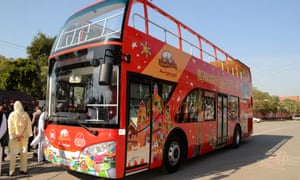
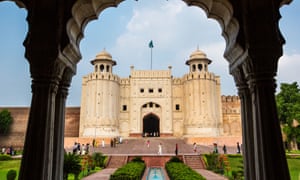
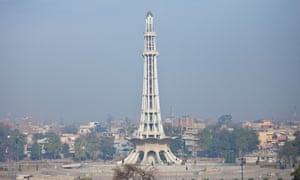
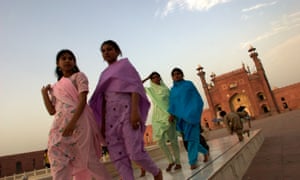
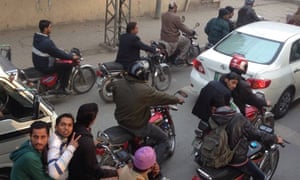
No comments:
Post a Comment